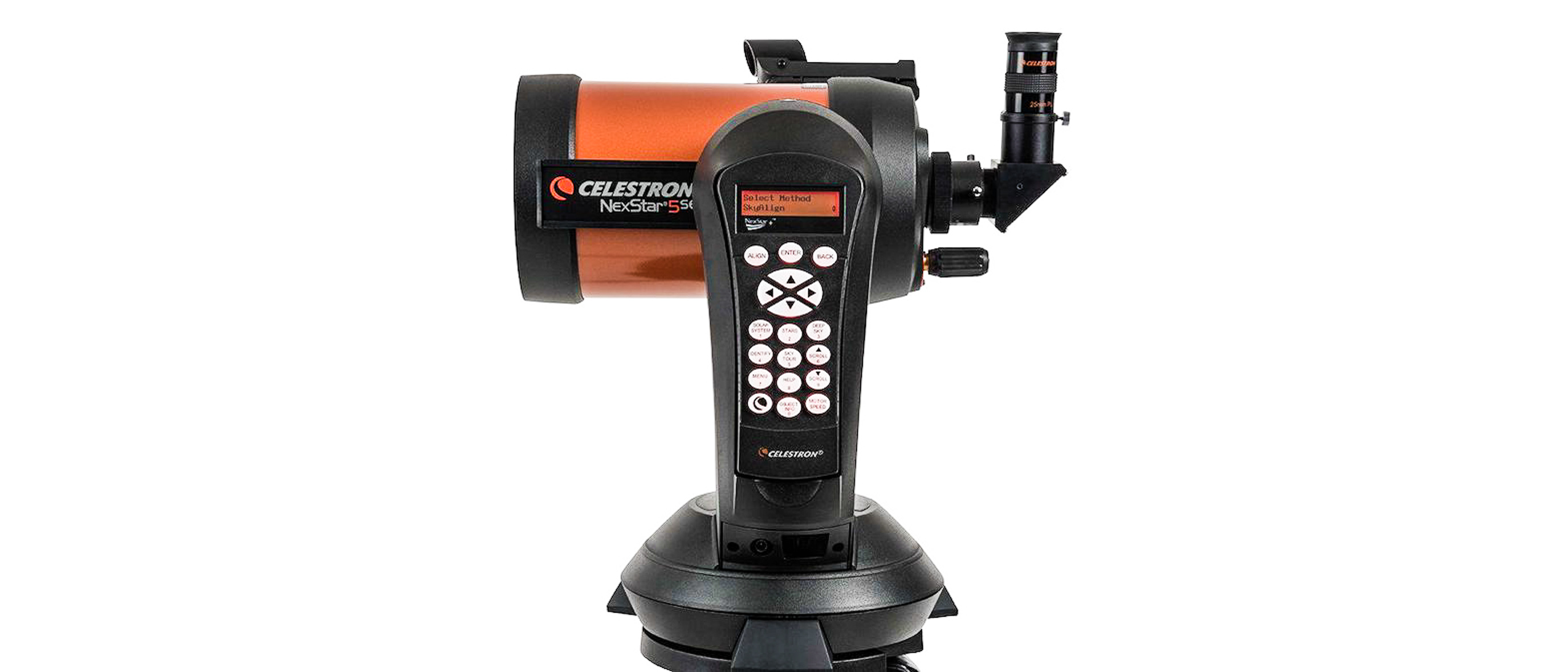Digital Camera World Verdict
The Celestron NexStar 5SE is a highly reliable, affordable and travel-friendly telescope that oozes accessibility and versatility from its classic orange Celestron optical tube. In its size and price class, it’s hard to beat, and with SkyAlign, it has a beginner-friendly system for getting started that will also be highly prized by more experienced astronomers who want to get going quickly before the clouds roll in. The long focal length and high focal ratio tailor the NexStar 5SE to lunar and planetary imaging in particular, and it will facilitate great images of the our neighbors in the Solar System as well as some of the brighter deep-sky objects such as the Orion Nebula or the Andromeda Galaxy.
Pros
- +
(Almost) complete package for beginners
- +
Portable
- +
Versatile
- +
Good GoTo system
- +
Best at planetary imaging
Cons
- -
Only one eyepiece of average quality
- -
Motors drain batteries quickly
- -
Not perfect for imaging faint deep-sky objects
- -
Long-exposure astrophotography is restricted
Why you can trust Digital Camera World
The Celestron NexStar 5SE follows Celestron's tradition of making exceptional Schmidt-Cassegrains, and is one of the most recent in a long line of five-inch aperture models dating back to the early 1970s. The NexStar 5SE lives up to the reputation of its predecessors, only with added bells and whistles in the form of a motorized GoTo mount that provides access to almost 40,000 moons, planets, stars, nebulae, clusters and galaxies in its database.
As a general rule of thumb, how much you can see with your telescope depends largely on its aperture. Pleasingly, if there were a Venn diagram of telescope aperture and portability, the NexStar 5SE would be in the intersection – compact enough to be transportable, but with enough aperture to resolve small details or drink in enough light to see or image fainter objects well. An excellent offering that's not only suitable for beginners, but also for seasoned astronomers hunting for a "grab and go" instrument that delivers exceptional image quality at the touch of a button.

Celestron NexStar 5SE: Specifications
Optical design: Schmidt-Cassegrain
Aperture: 125mm
Focal length: 1250mm
Focal ratio: f/10
Optical tube length: 330mm
Optical tube weight: 2.7kg
Mount weight: 3.2kg
Total kit weight: 8kg
Includes: Optical tube, single-arm fork mount, steel tripod, red-dot finderscope, NexStar+ hand controller, 25mm eyepiece, star diagonal
Database: 38,181 objects
Power: 8xAA batteries, 12V external source
Celestron NexStar 5SE: Design & key features
The Celestron NexStar 5SE is the "special edition" version of the venerable NexStar 5, its optical tube assembly emblazoned in Celestron’s iconic metallic orange. It’s a classy look, complementing the sleek single-arm fork GoTo mount that the NexStar family of telescopes are famed for.
The optical tube assembly (OTA) attaches to the mount via a standard Vixen-style dovetail bar, which gives the telescope and mount substantial versatility if you want to mix and match for the perfect set up. Beware that the mount's DC servo motors are power hungry and drains the 8 AA batteries very quickly, particularly during the colder months. It can be fixed up to a 12V external power source (we recommend the Celestron Powertank), but this will need to be purchased separately.
Given its price – for which you get the OTA, computerized altitude-azimuth single fork mount, sturdy steel tripod, StarPointer red-dot finder, a 1.25-inch star diagonal and a 25mm eyepiece – and size, the NexStar 5SE makes a perfect telescope for both newcomers to skywatching as well as the travelling astronomer.
With the NexStar 5SE, everything is easy to assemble and disassemble, making it perfect for taking to a dark-sky site or star party: it's compact enough to transport in the back of your vehicle or even as airplane luggage, given that the total kit weight is just 8 kg (17.6 lbs).
The best camera deals, reviews, product advice, and unmissable photography news, direct to your inbox!
Of course, getting your telescope and setting it up correctly is just half the job – there’s also the task of finding your way around the night sky. The NexStar 5SE offers a neat way of doing this using its SkyAlign technology. It’s all about the telescope figuring out its orientation with respect to the night sky above it.
It works by simply pointing the telescope towards three bright, naked-eye objects in the sky. They could be a planet, the Moon, or even a bright star. You don’t even need to know what those objects are – once the telescope tube is pointed at these objects, you simply press "align" on the hand controller and the NexStar 5SE's computerized mount and database is able to work this out. Thanks to its built-in database, it then "knows" where everything else is in the sky with respect to those three naked-eye objects that you used to align.
It’s a perfect system for beginners, who may not know Arcturus from Sirius. Once the telescope is aligned, use the hand controller to ask it to move to the object that you want to observe – the technology is so accurate that, more often than not, you'll find your target at the center of the field of view after you have instructed the NexStar 5SE to slew to it. There are nine different slewing speeds to choose from.
Celestron NexStar 5SE: Performance
As you might expect from a Celestron telescope, the optics are of high quality for the price. Being a Schmidt-Cassegrain, the NexStar 5SE has a corrector plate, concave primary mirror and convex secondary, which allows the user to make use of the compact OTA without compromising focal length. An ordinary mirror reflects only 4-5% of the light that falls on it – that isn’t very helpful when straining to see faint stars and galaxies, so optical coatings on the NexStar 5SE's mirrors maximize the amount of light for breathtaking views.
The StarBright XLT coatings on the NexStar 5SE's mirrors reflect an impressive 95% of the light that’s incident on them, meaning that there is very little light loss as the distant starlight is reflected from the primary to the secondary and then through to your eyepiece.
The telescope's reasonably long focal length, which results in a f/10 focal ratio, makes this Schmidt-Cassegrain more of a planetary performer. With this in mind, we turned our attention to gas giant Jupiter, which was at a good position in the sky during our observations. The GoTo made short work of locating the Jovian planet and its four largest satellites: Io, Europa, Ganymede and Callisto. In the field of view, the gas giant is appears as a bright disk, with faint brown and cream bands visible. The views just improved as we upped the magnification. No color fringing is visible, and images are crisp with a high level of contrast, which is important for seeing details on planets.
With a waning gibbous Moon a few degrees away from Jupiter, we observed the cratered surface with ease. Well-defined crater walls and lunar mare are captured to a very high standard, appearing crystal clear through the modest 5.91-inch aperture.
While we feel this instrument is best for Solar System targets, the NexStar 5SE provides fair views of bright deep-sky targets such as the Orion Nebula (Messier 42). This diffuse fuzzy star-forming region is clear in the field of view, with stars in the Trapezium Cluster at its center sparkling with excellent clarity.
The 25mm Plössl eyepiece that comes with the NexStar 5SE is of a reasonable quality, offering a magnification of 50x. To make the most of the optical system though, you’ll want to invest in other eyepieces with a variety of magnifications.
The alt-azimuth nature of the mount does work against it a touch if you're looking to partake in serious long-exposure astrophotography. However, given the telescope's versatile Vixen dovetail, there is a work around, and users can still make use of the exquisite optical system using an equatorial mount that's able to track the sky. This will assist with exposures of longer than a minute.
Admittedly, Celestron has attempted to negate this by including a built-in wedge that tips the telescope into equatorial mode, but it’s not as accurate in its tracking as a purpose-built equatorial mount. We did take a step back from the NexStar 5SE's lunar, solar and sidereal tracking a test for a few minutes after positioning the OTA on a lone star. The target hadn't drifted massively at the field of view, but it's worth recognizing this instrument's limitations and choosing your astrophotography targets carefully if you're keen to make use of the computerized mount.
For beginners, it suffices if you’re willing to put up with slightly blurry shots of fainter targets as the tracking tries to keep up with the target as the sky turns. For brighter objects – such as the Moon, Jupiter and Saturn – exposures of less than a minute are fine and we achieved dazzling results.
Celestron NexStar 5SE: Verdict
Overall, for the price, this is an excellent telescope that – absent of a few more eyepieces – has everything you need to get started, whether it be planetary, lunar and bright-deep sky astroimaging or simply a spot of stargazing. More advanced astronomers will love it for its portability, but remember that serious long-exposure imaging won't yield hugely stellar results.
Planetary imagers will get the most out of the NexStar 5SE – surface features on Mars, the belts and Great Red Spot of Jupiter, and the rings of Saturn will really pop out through this telescope, and you won’t need hugely long exposures to do it.
For fainter, more diffuse objects, the long focal length and high focal ratio work against it without the addition of a focal reducer, but that’s to be expected with Schmidt-Cassegrain designs. It’s why some of the world’s top planetary imagers use these catadioptric instruments, while deep-sky observers will opt for short focal length refractors.
The alt-azimuth mount can be considered a limitation, and you’ll want to upgrade to an equatorial mount at some point if you intend to pursue serious astrophotography. Alternatively, we advise choosing your imaging targets carefully.
The GoTo mount does tend to drain batteries, so we advise investing in a constant power supply like a Celestron Powertank for uninterrupted imaging and observing.
Read more:
The best lenses for astrophotography
The best camera equipment for astrophotography
The best telescopes for astrophotography
The best CCD cameras for astrophotography
Best light pollution filters for astrophotography
Gemma is content director of science and space magazines How It Works and All About Space, history magazines All About History and History of War as well as Science, Technology, Engineering, Arts and Mathematics (STEAM) kids education brand Future Genius. She is the author of several books including "Quantum Physics in Minutes", "Haynes Owners’ Workshop Manual to the Large Hadron Collider" and "Haynes Owners’ Workshop Manual to the Milky Way". She holds a degree in physical sciences, a Master’s in astrophysics and a PhD in computational astrophysics. She was elected as a fellow of the Royal Astronomical Society in 2011. Previously, she worked for Nature's journal, Scientific Reports, and created scientific industry reports for the Institute of Physics and the British Antarctic Survey. She has covered stories and features for publications such as Physics World, Astronomy Now and Astrobiology Magazine.





